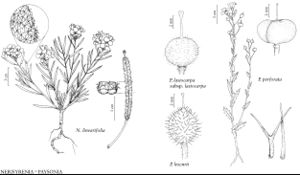Nerisyrenia
Pittonia 4: 225. 1900.
Perennials [subshrubs]; (caudex woody); not scapose; usually pubescent, sometimes glabrous or glabrate, trichomes long-stalked to subsessile, dendritic. Stems (few to several from base), erect to ascending, branched distally. Leaves cauline; not rosulate; petiolate or sessile; blade (often fleshy), margins entire, dentate, or repand, sometimes revolute. Racemes (corymbose, several-flowered, lax). Fruiting pedicels divaricate to ascending, or, rarely, recurved, slender. Flowers: sepals spreading to reflexed, oblong or lanceolate to ovate [linear]; petals usually white (often fading lavender), rarely lavender, obovate to spatulate [broadly elliptic], (longer than sepals), claw well-differentiated from blade, (dilated and denticulate basally); stamens slightly tetradynamous, (somewhat spreading); anthers linear, (base sagittate, apex obtuse); nectar glands confluent, subtending bases of stamens. Fruits siliques or silicles, sessile, linear to oblong [obovoid], smooth [torulose], straight or curved, angustiseptate, terete, [or latiseptate]; valves each with distinct midvein, pubescent [glabrous]; replum rounded; septum complete; ovules 30–100 per ovary; style distinct; stigma conical, 2-lobed (lobes connivent, decurrent). Seeds uniseriate or biseriate, plump, not winged, oblong [elliptic]; seed-coat mucilaginous when wetted; cotyledons incumbent. x = 9, 10
Distribution
s United States, n Mexico
Discussion
Species 7–9 (2 in the flora).
Parrasia Greene (1895), not Rafinesque (1837) is an illegitimate name, sometimes found in synonymy with Nerisyrenia.
Selected References
Lower Taxa
Key
| 1 | Leaf blades usually obovate to spatulate or oblanceolate, rarely elliptic, (4-)7-20(-30) mm wide, not fleshy. | Nerisyrenia camporum |
| 1 | Leaf blades linear to linear-oblanceolate, 1-4.5 mm wide, fleshy. | Nerisyrenia linearifolia |
"elongated" is not a number."thick" is not a number.
